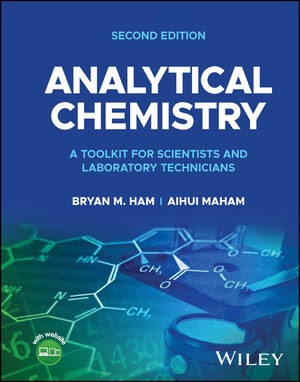About the ANALYTICAL CHEMISTRY book
 Analytical Chemistry Book by the Authors, Taught in the Courses, and Contains ChemTech Toolkit Preface
Analytical Chemistry Book by the Authors, Taught in the Courses, and Contains ChemTech Toolkit Preface
This book is an analytical chemistry book that has two forms, a traditional hardcover book, and an electronic version contained within an analytical chemistry toolkit program. Today’s students, technicians, and chemist are all familiar with and daily use a computer. Many textbooks are being converted to online and electronic versions where students study the electronic books using computers or hand held electronics such as Kindles. The book begins with an introduction to the laboratory including safety, glassware, and lab basics, and then moves through the fundamentals of analytical techniques such as spectroscopy and chromatography, most common lab instrumentation, and examples of laboratory programs such as laboratory information management systems (LIMS). The book also includes a companion teaching, reference, and toolkit program called ChemTech-ToolKit. The ChemTech-ToolKit program contains lesson exercises that stress and review over topics covered in the book, it contains useful calculators, an interactive periodic table, and a summary of all of the chapters of the book.
The analytical chemist and technician are an invaluable part of the chemistry laboratory. He or she is charged with performing analyses, updating records, taking inventory, documenting projects, keeping the laboratory clean, updating instrumentation and analyses, making sure the lab is safe and giving support to the chief chemist are just a brief description of what the chemist and technician may be charged with. Choosing a career as a chemist or technician in any type of laboratory such as environmental, petroleum, contract, medical, clinical or biological to name a few examples can be a very rewarding career. Some positions are more demanding than others, but most are challenging. New methods are often needed to be learned or developed. New instrumentation is needed to be set up and used. The chemist and technician also need to keep track of the testing that is being performed and documenting results.
The technicians and chemists in laboratories today are also routinely using computers on a daily basis. Computers are used to control instrumentation and record the data that is being produced. The instrument vendors also often have their own software used for their instruments that the technician, chemist, or laboratory worker needs to learn and use on a routine, daily basis. The personal computer is also used by the chemist and technician on a daily basis for entering laboratory data and writing reports. It is pretty safe to say that most students today have been introduced to the basic operations of the personal computer. A very useful computer program found in most laboratories today is the laboratory information management system (LIMS). LIMS are used to input data, track sample progress, record sample data such as company, type, and tests needed and so forth. Later in Chapter 12 we will be introduced to a LIMS example that we will use to log in samples, input data, search samples, approve samples, and print reports and certificates of analysis (C of A). Also becoming more common in labs are electronic laboratory notebooks, and we will take a brief look at using them.
This book is a comprehensive study of analytical chemistry as it pertains to the laboratory analyst and chemist. There are numerous chapters in the book devoted to the basics of analytical chemistry and introductions to the laboratory. The book includes an interactive program called ChemTech-ToolKit for chemists and laboratory technicians. The program acts as a learning aid as we move through the various aspects of analytical chemistry laboratory work and the needed skills to be learned. The ChemTech-ToolKit program has reference tables and an interactive periodic table. It has a link to a LIMS program that we will learn to use. The program also has a review of most of the chapters in this book. The combination of the ChemTech-ToolKit program and the chapters in this book can help to prepare the student for a rewarding career as a chemist or a laboratory technician. The book is also a useful reference for the established chemist or technician already working in the laboratory.
The ChemTech-ToolKit program is a teaching tool designed to equip the chemist, the laboratory analyst, and the technician for a career in the analytical laboratory whether it is a clinical lab, an industrial, petrochemical, petroleum, environmental, college or university, or contract lab. The book covers the basics of the laboratory including safety, glassware, and balances. Most of the fundamental aspects of laboratory analysis are also covered including titrations, chromatography, and instrumental analyses. Because the ChemTech-ToolKit program contains key points of most of the chapters, ChemTech-ToolKit can be used as a reference and toolkit for the chemist and technician throughout his career. ChemTech-ToolKit progresses from the basics of lab fundamentals in safety and glassware through advanced laboratory techniques and analyses. The ChemTech-ToolKit program and the book are a valuable source of reference material also for the industrial or academic researcher in the laboratory. The program and book are in a convenient format for looking up techniques and information in one place for numerous aspects of the lab and of samples whether it’s the analyst, chemist, or researcher using them. The book and program can also be useful as a supplemental learning source for the college student studying the sciences such as the chemistry, biology, or premed student. The combination of this book with the ChemTech-ToolKit program would be a perfect approach for a community college that is designing a program that would teach and prepare laboratory technicians for an associate degree, and an undergraduate analytical chemistry textbook.
The book also meets the need of an undergraduate or graduate level analytical chemistry class as all the main topics of analytical chemistry are covered.
